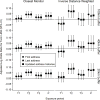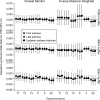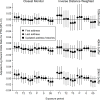Particulate air pollution, fetal growth and gestational length: The influence of residential mobility in pregnancy
- PMID: 26918840
- PMCID: PMC4821760
- DOI: 10.1016/j.envres.2016.02.001
Particulate air pollution, fetal growth and gestational length: The influence of residential mobility in pregnancy
Abstract
Background: It remains unclear as to whether neglecting residential mobility during pregnancy introduces bias in studies investigating air pollution and adverse perinatal outcomes, as most studies assess exposure based on residence at birth. The aim of this study was to ascertain whether such bias can be observed in a study on the effects of PM10 on risk of preterm birth and fetal growth restriction.
Methods: This was a retrospective study using four pregnancy cohorts of women recruited in Connecticut, USA (N=10,025). We ascertained associations with PM10 exposure calculated using first recorded maternal address, last recorded address, and full address histories. We used a discrete time-to-event model for preterm birth, and logistic regression to investigate associations with small for gestational age (SGA) and term low birth weight (LBW).
Results: Pregnant women tended to move to areas with lower levels of PM10. For all outcomes, there was negligible difference between effect sizes corresponding to exposures calculated with first, last and full address histories. For LBW, associations were observed for exposure in second trimester (OR 1.09; 95% CI: 1.04-1.14 per 1μg/m(3) PM10) and whole pregnancy (OR 1.08; 95% CI: 1.02-1.14). For SGA, associations were observed for elevated exposure in second trimester (OR 1.02; 95% CI: 1.00-1.04) and whole pregnancy (OR 1.03; 95% CI: 1.01-1.05). There was insufficient evidence for association with preterm birth.
Conclusion: PM10 was associated with both SGA and term LBW. However, there was negligible benefit in accounting for residential mobility in pregnancy in this study.
Keywords: Exposure misclassification; Fetal growth; Pregnancy; Preterm birth; Residential mobility.
Copyright © 2016 Elsevier Inc. All rights reserved.
Conflict of interest statement
Conflicts of interest: none declared.
No competing financial interests.
Figures




References
-
- Sapkota A, Chelikowsky AP, Nachman KE, Cohen AJ, Ritz B. Exposure to particulate matter and adverse birth outcomes: a comprehensive review and meta-analysis. Air Quality, Atmosphere & Health. 2012;5:369–81.
-
- Zhu X, Liu Y, Chen Y, Yao C, Che Z, Cao J. Maternal exposure to fine particulate matter (PM2. 5) and pregnancy outcomes: a meta-analysis. Environmental Science and Pollution Research. 2014:1–14. - PubMed
-
- Canfield MA, Ramadhani TA, Langlois PH, Waller DK. Residential mobility patterns and exposure misclassification in epidemiologic studies of birth defects. J Expo Sci Environ Epidemiol. 2006;16:538–43. - PubMed
-
- Chen L, Bell EM, Caton AR, Druschel CM, Lin S. Residential mobility during pregnancy and the potential for ambient air pollution exposure misclassification. Environmental research. 2010;110:162–8. - PubMed
Publication types
MeSH terms
Substances
Grants and funding
LinkOut - more resources
Full Text Sources
Other Literature Sources
Medical

